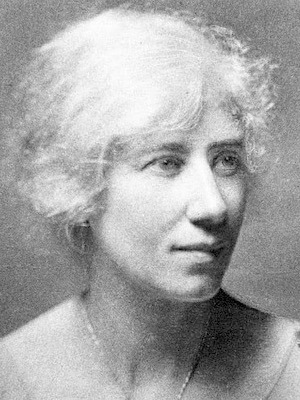Julia Bell
Julia Bell (1879 – 1979) was an English human geneticist.
Dr Julia Bell was one of the pioneers and key founders of human and medical genetics.
Bell’s unique combination of mathematical training, clinical expertise and genetic knowledge helped yield important insights into human inheritance. Her scholarly, methodical approach to the study of human diseases is exemplified by numerous chapters and entire sections in the voluminous Treasury of Human Inheritance. Bell was the principle author of Volume II (1922-1932); Volume IV (1934-1947); and Volume V (1951-1958).
Landmark article 1937 with JBS Haldane (1892-1964) describing the linkage between the genes for colourblindness and haemophilia on the X chromosome.
Biography
- Born 28 January 1879 at Sherwood, Nottinghamshire
- 1898 – Admitted to Girton College, University of Cambridge taking the Mathematical Tripos examination in 1901. However women were not able to officially receive degrees from Cambridge University.
- 1902-1907 Worked at Cambridge Observatory investigating solar parallax. Bell was awarded a Master’s degree (MA) from Trinity College, Dublin. on the basis of this work.
- 1908-1914 Statistical assistant to Karl Pearson (1857-1936) in the worlds first university statistics department at University College, London. Pearson persuaded Bell to take a medical degree to diversify the expertise within the Galton Laboratory.
- 1914-1920 Conjoint diploma (MRCS, LRCP) in medicine from the London School of Medicine for Women, at the Royal Free Hospital (the only medical school in England accepting women at that time).
- 1920-1933 Research fellow at Galton laboratory
- 1926 – MRCP
- 1933-1944 Research staff member of the Medical Research Committee on human genetics
- 1936-1944 Research staff member of the Neurological Research Unit at the National Hospital, Queen Sqaure
- 1938 – Fellow of the Royal College of Physicians
- 1941 – Weldon Memorial Medal (Oxford University)
- 1944 – Retired…
- 1944-1965 Honorary research fellow at the Galton laboratory; and the Neurological Research Unit at the National Hospital
- Died 26 April 1979, shortly after her 100th birthday
Medical Eponyms
Martin-Bell syndrome (1943) – aka Fragile X Syndrome
In 1943 Julia Bell and James Martin published the paper entitled A pedigree of mental defect showing sex linkage which describes a family in which 11 males, across two generations, had severe intellectual disability of a similar nature. They concluded that this was likely an inherited syndrome caused by an x-linked recessive gene. Initially named eponymously after them, Martin-Bell Syndrome is now recognised as Fragile-X Syndrome.
Fragile X Syndrome is the leading cause of inherited intellectual disability. It is an x-linked trinucleotide repeat disorder resulting in intellectual disability, predominantly affecting males, although females can have a milder phenotype. It is caused by “CGG” trinucleotide repeats in the fragile X mental retardation 1 (FXMR1) gene resulting in loss of production of the fragile X mental retardation protein (FMRP) which is required for normal brain development. Features of Fragile X Syndrome include:
- intellectual disabilities, ranging from mild to severe
- behavioral symptoms such as attention deficit disorder and autistic behaviors
- speech and language delay with expressive language affected more than receptive language
- physical characteristics which may not be evident until puberty include a long narrow face, large head, large ears, flexible joints, flat feet, and macroorchidism.
Key Medical Contributions
Treasury of Human Inheritance
Published between 1909 and 1958, from the Galton Laboratory, University College, London. One of the earliest series of documentations and analyses of human genetic disorders. An updated compendium of the of the described medical disorders providing the foundation for subsequent clinical and molecular genetic studies.
Her 1927 paper with JB Haldane The linkage between the genes for colour-blindness and haemophilia in man identified the linkage between the genes for colourblindness and haemophilia on the X chromosome.
Her 1959 publication On rubella in pregnancy reviewed 712 cases of maternal rubella during pregnancy, concluding that the high risk period for foetal complications was the first 12 weeks of pregnancy.
Major Publications
- Pearson K, Bell J. I. Section II. The femur of the primates. In: A study of the long bones of the English skeleton. 1919
- Bell J. Anomalies and diseases of the eyes. In: Treasury of human inheritance (Volume II). Eugenics laboratory memoirs XXI. 1922
- Bell J. Hereditary Optic atrophy (Leber’s disease). In: Treasury of human inheritance (Volume II(IV)). Eugenics laboratory memoirs XXI. 1922
- Bell J, Haldane JB. The linkage between the genes for colour-blindness and haemophilia in man. Proc. R. Soc. Lond. B. 1927; 123: 119-150
- Bell J. A determination of the consanguinity rate in the general hospital population of England and Wales. Ann Eugenics 1940;10:370-91
- Martin JP, Bell J. A pedigree of mental defect showing sex linkage. J Neurol Psychiatry. 1943;6(3-4):154-157.
- Bell J. On rubella in pregnancy. Br Med J. 1959;1(5123):686-688.
References
Biography
- Obituary. Julia Bell. Br Med J 1979;1:1288
- Obituary. Julia Bell. Lancet 1979; 313(8126): 1152
- Robson E. Obituary: Julia Bell. Nature 1979; 281: 163-164
- Beighton P, Beighton G. BELL, Julia (1879-1979). In: The Man Behind the Syndrome. Springer 1991: 14-16
- Bundey S. Julia Bell (1879-1979). Steamboat Lady, statistician and geneticist. J Med Biogr. 1996;4(1):8-13.
- Harper PS. Julia Bell and the Treasury of Human Inheritance. Hum Genet. 2005;116(5):422-432
- Biography: Bell, Julia. Lives of the Fellows of the Royal College of Physicians of London. Munk’s Roll: Volume VII: 31.
- Bibliography. Bell, Julia. WorldCat Identities
Eponymous terms
- Opitz JM, Westphal JM, Daniel A. Discovery of a connective tissue dysplasia in the Martin-Bell syndrome. Am J Med Genet. 1984;17(1):101-109
- What is Fragile X Syndrome? CDC
Studied at Univerisity of Cambridge - BA MB BChir. British doctor working in emergency medicine in Perth, Australia. Special interests include primary care and emergency medicine.


